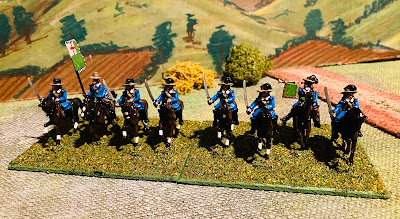A brief recap. I am playing a scenario devised by Steven on his blog Sound Officers Call! It is called Scenario #31 - ECHELONED ATTACK. Although inspired by the Battle of Aspern-Essling (1809), my game is set during the English Civil War.
Bacground
A Royalist force, under the leadership of Lord Cedric Harrington has moved across the river Eldernorth into territory controlled by Parliament. To counter this unexpected move Parliamentarian forces under the command of Colonel Charles Ashcroft, have hurriedly organised their dispersed forces to attack the Royalist bridgehead from various directions.
 |
| At some point in the battle. |
I have to admit I made a slight error regarding the reinforcement points compared to the original scenario. Somewhere between taking notes and setting up the tabletop, I inadvertently omitted a reinforcement point for Parliament. Hoping that my oversight didn't significantly impact the scenario, I continued with the game.
 |
| Tabletop setup. |
Order of Battle…
A note regarding the order of battles. I allocated 9 points per army, where detachments of dragoons and commanded shot, as well as guns, are half a point each, while full units like infantry and cavalry are counted as one point each.
Royalists force on the tabletop:
- 2 x Commanded Shot
- 1 x Infantry
- 1 x Cavalry
- 2 x Guns
- 2 x Ammunition Supply Carts
Royalist forces in reserve:
- 2 x Infantry
- 3 x Cavalry
- 1 x Ammunition Supply Cart
Parliamentarian force off-table:
- 4 x Dragoons
- 4 x Cavalry
- 3 x Infantry
- 3 x Ammunition Supply Carts
Note - Ammunition carts are used to resupply artillery and infantry units when they run out of ammunition. One cart can result one unit only.
Opening moves of the battle…
In anticipation of nearby Parliamentarian forces arriving, Lord Cedric Harrington deployed his available troops and guns in a defensive line stretching between the village of Oakfield and the hamlet of Little Yallop. Commanded shot units were stationed in Oakfield and Little Yallop, with a reserve cavalry unit positioned behind Oakfield.
 |
| The Royalist defensive line and reserve cavalry wait for the Parliamentarian forces to arrive. |
Assault on Oakfield…
The Parliamentarian forces, consisting of dragoon detachments and cavalry, initially arrived to the west of Oakfield village. In response, the Royalist reserve cavalry swiftly charged Parliament's cavalry, while the dragoons began their assault on the village. Meanwhile, the Royalist artillery were proving highly effective, delivering accurate and relentless fire on the Parliamentarian infantry who were advancing from the north to reinforce the attack on Oakfield.
 |
| The initial assault on Oakfield village. |
The Royalist cavalry, after a delay, arrived just in the nick of time to witness the fall of Oakfield to the enemy assault. Without hesitation, they spurred their horses onward, charging into Parliament's cavalry to the west and others moved to reinforce the defensive line, which was starting to retreat in the face of overwhelming numbers.
 |
| Royalist cavalry reinforcements arrive just in time. |
 |
| The Royalist defensive line is stabilised as reinforcements move into position. |
Attack on Little Yallop…
As the Royalist forces worked to reorganise their defensive positions and reclaim Oakfield amid some fierce fighting, the battle intensified in and around the hamlet of Little Yallop. Parliamentarian troops began to arrive from the northeast along the road, sparking fierce clashes. Parliamentarian dragoons spearheaded the initial assault on Little Yallop supported by their infantry. In response, Royalist cavalry made a decisive charge, routing not only the infantry, but pursuing some of the dragoon detachments to provide some relief for the commanded shot defending Little Yallop.
 |
| Royalists stabilise their defensive line and attempt to retake Oakfield. |
 |
| Royalist cavalry successfully see off some Parliamentarian cavalry, then charge off after them. |
 |
| The attack on Little Yallop heats up as Royalist cavalry make a charge to relieve the situation. |
Height of the battle…
At the height of the battle, both commanders were frantically throwing any available reinforcements into the engagement to secure control over Oakfield and Little Yallop, pivotal points in the battle. Despite numerous assaults, Parliament were able to maintain control around Oakfield, with dwindling units on both sides as the fierce fighting had taken is toll. Meanwhile, to the east, additional Parliamentarian cavalry arrived, successfully routing the troublesome Royalist cavalry who's gallant charge had undoubtedly saved the defenders of Little Yallop.
 |
| The battle for Oakfield at is height. |
 |
| Parliamentarian forces are able to retain control of Oakfield. |
 |
| The timely arrival of Parliamentarian cavalry are thrown into battle. |
 |
| The Royalist cavalry are routed while the defenders of Little Yallop watch on. |
The final assault…
In a final attempt to recapture the village of Oakfield, Lord Cedric Harrington, the Royalist commander, rallied his remaining infantry for one last assault. The attack nearly succeeded in dislodging Parliament's infantry, but ultimately failed as enemy cavalry intervened, routing this final Royalist assault and their commander.
Note - the final assault was one of those anything but a one situations, and then a one is rolled.
 |
| The Royalist infantry are rallied and make a final assault. |
 |
| Parliamentarian defenders just hold on long enough for their cavalry to arrive. |
 |
| The Royalist infantry and commander are routed. |
Who won?
At the end of the game, each army maintains control of one of their objectives, Oakfield village and Little Yallop hamlet, but the Royalist commander suffered a rout and left the field of battle. Hence, I am declaring a marginal victory for the Parliamentarian forces.
Steven’s scenario provided a most enjoyable weekend game. Link to post and scenario - here.
A final note - my newly painted Royalist cavalry performed well, unlike the usual trend where new units often struggle on the tabletop.




































